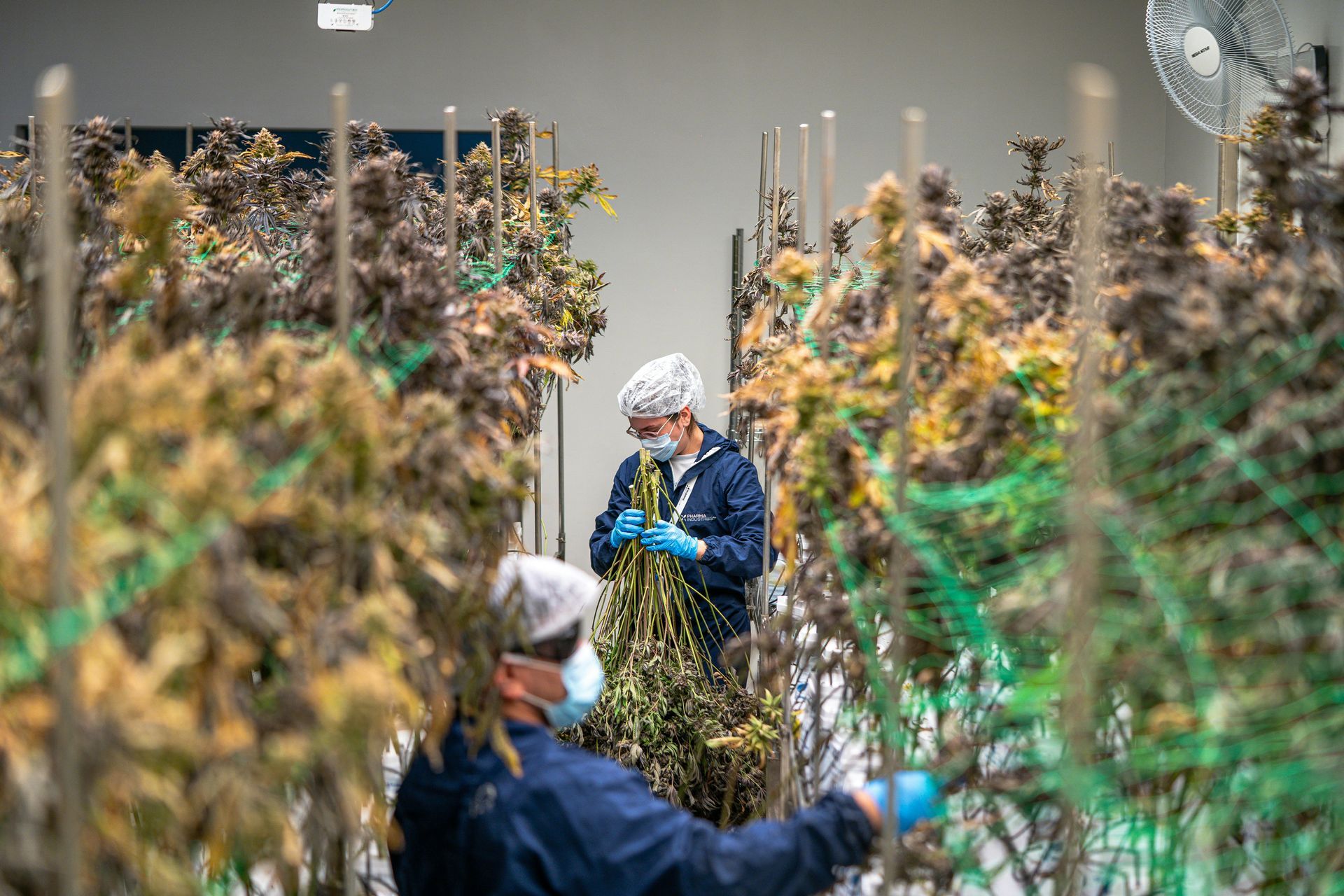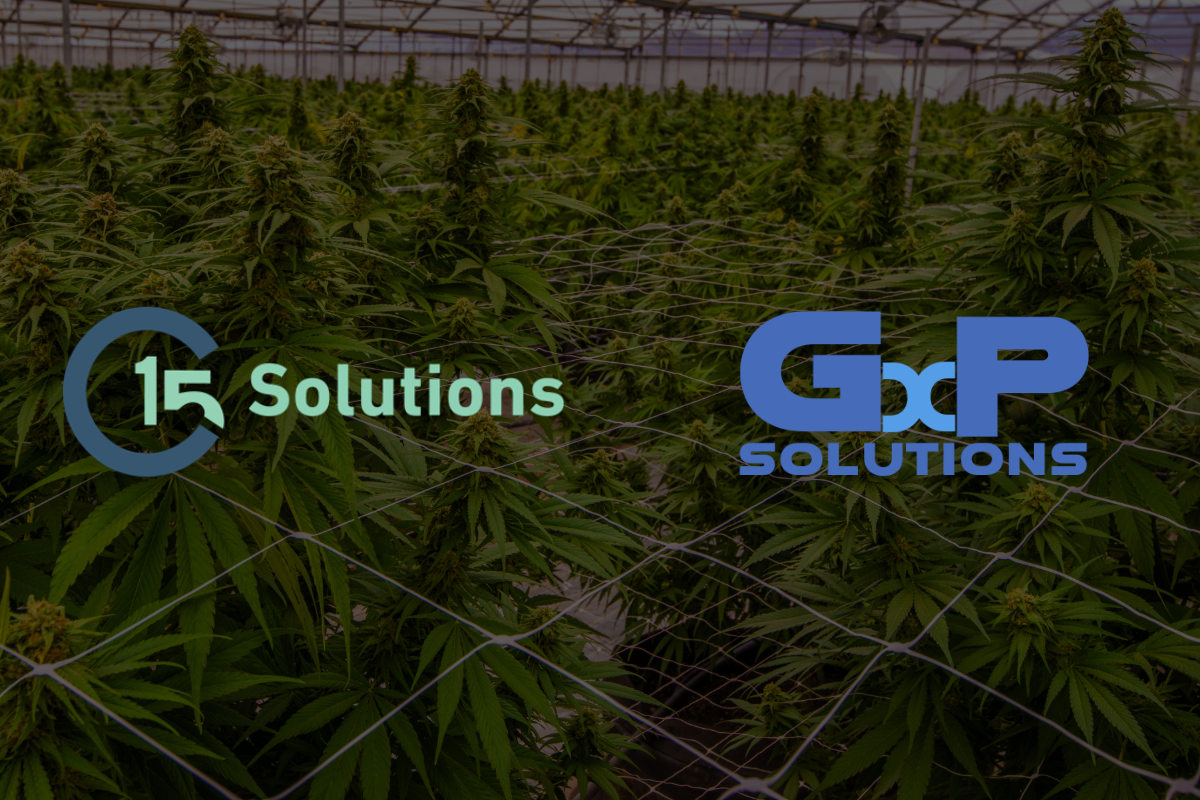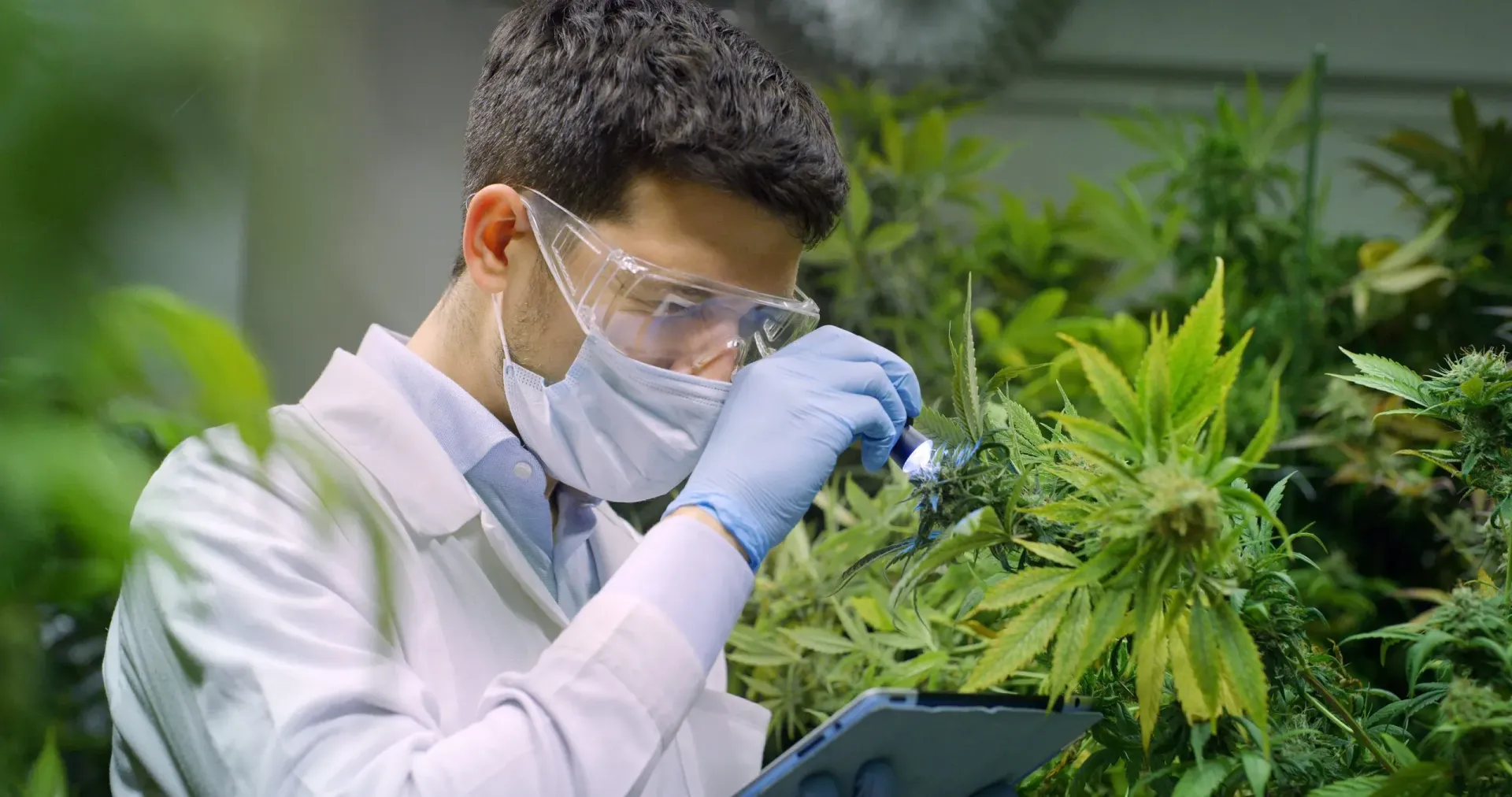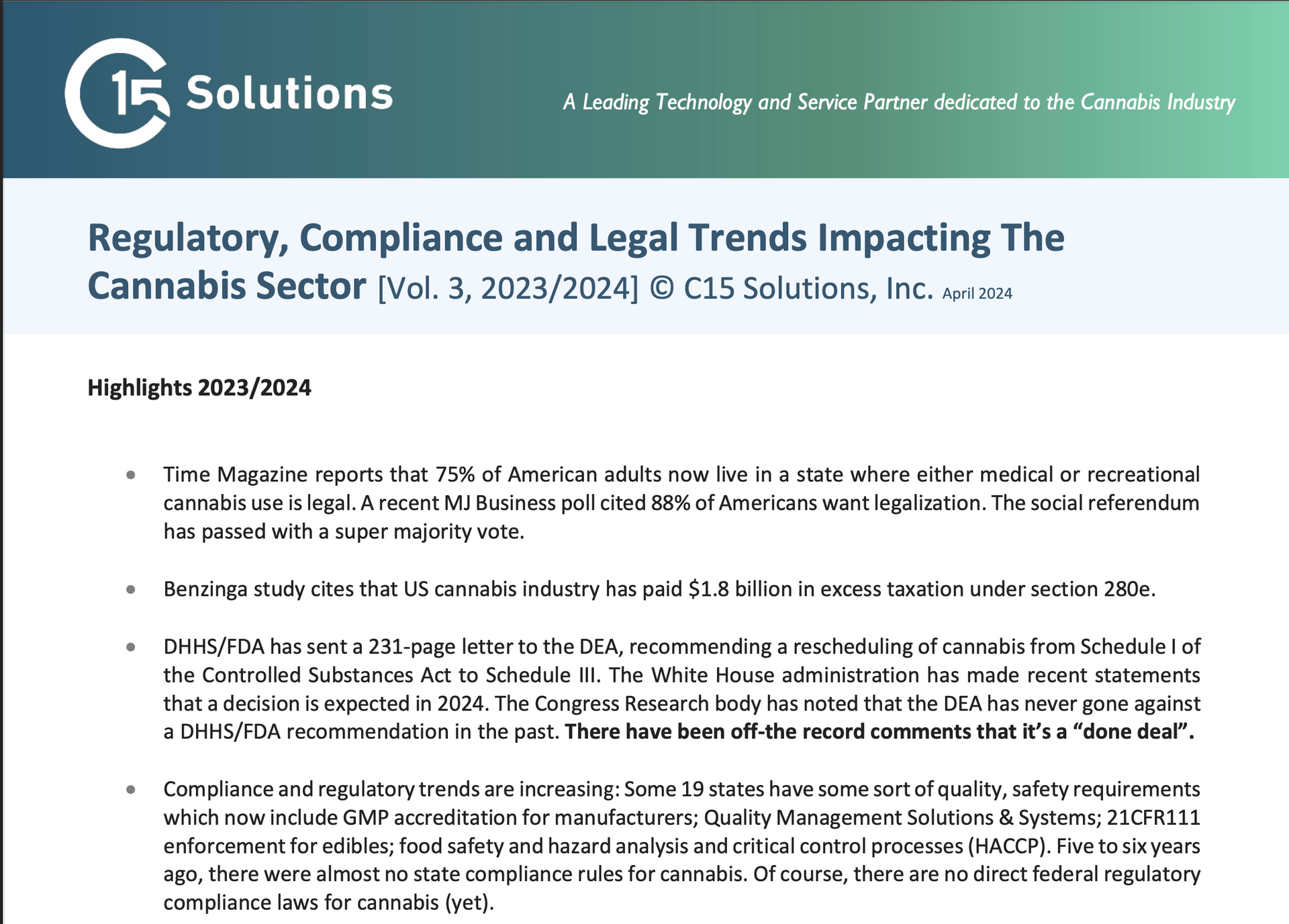News & Blog

Japan has one of the world’s oldest demographics and is ranked as the 4th largest GDP with no domestic production of cannabis products. On the surface this makes Japan a hugely attractive export market. Japan is a relatively new cannabis market, having amended its Cannabis Control Act in December 2024. One material result was to remove the blanket ban on cannabis-derived pharmaceuticals. The focus has changed to medical use of cannabis with an ultra low THC limit for these medical products – 0.001% THC to be specific. This creates a high bar for the cannabis manufactures that wish to service this market. The sector size is estimated to be anywhere between $115M - $145M with high growth forecasts of 28-30% CAGR (‘compound annual growth rate’) into 2030-2033 ( https://www.grandviewresearch.com/horizon/outlook/cannabidiol-market/japan ). Once those restrictions begin to ease, expect the growth rate and total addressable market to increase substantially. The upsides are obvious; Canadian exporters are not subject to (rather crippling) cannabis excise tax duty, immediately improving the economics vs. domestic sales. For US exporters, emerging APAC demand for compliant bulk ingredients and finished goods rewards the few suppliers who can consistently hit spec and prove it. One of the biggest challenges for exporters now, is of course meeting those strict THC thresholds. Unfortunately, because of the size of the shipments and potential for revenue loss if those thresholds aren’t met, there have been many cases of COA (‘certificate of analysis’) manipulation. Further to that, paper and email simply is not scalable – when permits, specifications, invoices and batch records all move through inboxes, you lose traceability, auditability and version control. Culturally, Japan places a very high value on partners who embrace a quality culture. People + Process + Technology This is where TrueImports and C15 Solutions come into play. TrueImports, led by Mary Szomjassy Brown and Robert Gregg, is an international certification and importation company that serves as a broker for aspiring exporters. The company has established a closed-loop system to ensure scalable, auditable, cannabinoid importation into Japan using C15 Solutions digital eQMS. TrueImports manages a C15 Solutions eQMS environment whereby all relevant exporter documentation and test results are uploaded into C15’s 21 CFR Part 11, EU Annex 11 and ERES (Japan equivalent) compliant ‘Vault’ with audit trails. C15 ‘Vault’ provides shared access to both the exporting producer and the Japanese Ministry of Health (JMH). TrueImports also works with multiple, designated labs recognized by Japan authorities that execute official testing for all cannabinoid exports into Japan. The exporting producer will upload specs, permits, batch records, COAs, and any other forms related to shipment into the C15 Vault for review by the international TrueImports team. Once reviewed, the JMH will then access the C15 Vault and approve the export for shipment. Tracking and any correction of issues is executed under an audit trail with full traceability across multiple versions of documents. The C15 Vault acts as a complete data repository, where all partner and client data is grouped into version controlled digital binders that are stored in perpetuity. Role based access ensures exporting partners only see what they are authorized to. In this scenario, TrueImports (the people) have created a closed-loop framework (the process) leveraging C15’s eQMS (the technology) to create a digital compliance bridge that ensure supply chain integrity for the Japanese medical market.

First off, here is a direct link to Health Canada’s website outlining the upcoming regulation changes for the Natural Health Product sector - https://www.canada.ca/en/health-canada/services/drugs-health-products/compliance-enforcement/good-manufacturing-practices/guidance-documents/guide-natural-health-products-0158.html . What Changed Clearer, end-to-end quality system expectations. Stronger emphasis on a documented QMS (‘Quality Management System’) - quality manual, roles, self-inspection, management engagement, and on the QAP’s explicit approval responsibilities. Role-by-activity mapping. Clarifies which GMP sections apply to manufacturers, packagers, labellers, importers, distributors, and storers (e.g., specs, premises, equipment, QA, records). Depending on your business, the rules are different. Testing modernization. Confirmatory testing encouraged for added assurance (esp. new or higher-risk suppliers). Reduced/rotational testing allowed with strict prerequisites (e.g., water activity, historical data, statistical confidence, ongoing controls) and clear OOS escalation rules. Composite testing generally not acceptable for finished products (risk of masking contaminants). Quantification by input permitted when controls and documentation meet defined criteria. Importer accountability upgraded. Ability to leverage MRA/PIC/S evidence (e.g., batch certificates) with continued Canadian release responsibility and periodic batch record oversight. Premises & utilities detail. Practical requirements for zoning, pest control, environmental monitoring, water quality , and documented storage conditions (including daily records). Equipment & personnel. Explicit expectations for fit-for-purpose equipment , cleaning/calibration logs, and training matrices with periodic GMP refreshers and effectiveness checks. Risk/CAPA appendices. Risk classification for observations and a structured CAPA process to standardize remediation. Why This Matters There is a firm deadline. By Mar 4, 2026, regulated parties must be able to provide evidence of compliance. Health Canada inspections will expect records, not intentions. Reduced testing = reduced risk only if controlled. The guide lets you cut cost/time without cutting assurance, but only with robust data (side note, it’s MUCH easier to collect and demonstrate data using an electronic QMS), supplier qualification, and QAP governance. Importing gets stricter. Leveraging foreign GMP is helpful, yet you remain responsible for Canadian release, label alignment, and periodic verification. Data integrity moves center stage. Daily environment logs, water results, calibration, training, CAPA, and batch review must be consistent, retrievable, and audit-ready . When it comes to data integrity, following the ALCOA++ framework is mandatory. ALCOA++ The full acronym ALCOA++ expands on the original ALCOA principles by adding completeness, consistency, enduring quality, and availability, as well as the most recent addition: traceability. Attributable : Data should be traceable to the person or system that generated it. Legible : Data must be in a readable and understandable form to allow for review. Contemporaneous : Data should be captured at the time the observation or activity occurs. Original : The data should be the first-hand capture of the observation, or a certified true copy. Accurate : The data must exactly reflect what was observed and recorded, with any changes or errors clearly documented. Complete : All data, including tests, reanalyses, and any missing information, should be recorded. Consistent : Data should be documented in a logical, orderly, and chronological sequence. Enduring : Records must be maintained in a permanent or semi-permanent form for the specified regulatory duration. Available : Data must be accessible for review, audits, and inspections throughout its entire lifecycle. Traceable : There should be a complete audit trail showing who changed what, when, and why. C15 eQMS Can Help C15 eQMS gives you the controls, traceability, and evidence this guide expects, straight out of the box: Specifications control & QAP release (complete with 21 CFR Part 11 compliant signatures that fully adhere to ALCOA++ principles) : versioned specs, change control, e-signatures, and a QAP dashboard for documented approvals and release decisions Testing strategy governance: workflows to design/justify reduced or rotational testing; automated COA analysis (to aggregate your test result data and do trend analysis), OOS handling, and seamless integration into digital batch records Importer toolkit: supplier qualification, COA ingestion, periodic batch record review reminders, and label control checks Equipment & training: calibration/Preventative Maintenance schedules, usage/cleaning logs, training matrices (full role-based curriculum training available) with read-and-understand and effectiveness checks, deviation handling CAPA & risk: built-in risk assessment for quality events and guided CAPA workflows aligned to the guide’s appendix. EXPERIENCE: C15 currently has 15+ customers operating in GMP production environments and our team of Customer Success Managers have a track record of success when it comes to assisting with audit preparation and validation of systems (another GMP requirement). Ready to hit GMP by March 2026? Speak with our experts and book a quick walkthrough of the C15 eQMS platform and become audit-proof for 2026.

As global cannabis trade accelerates, quality assurance (QA) and GMP/GACP-aligned systems aren’t optional, they’re the backbone of export success. Canada Leads Today But What Happens When the U.S. Joins? Canada remains the dominant exporter into key medical markets like the UK, Israel, Portugal and Germany. In Q2-2025, Germany imported 43,257 kg of medical cannabis, nearly half (20,107 kg) coming from Canada - up from 16,057 kg in Q1. Portugal was second at 13,465 kg . What could unlock U.S. exports. The U.S. is moving toward a federal shift (e.g., rescheduling to Schedule III has been formally proposed and is under rulemaking), which, while not full legalization, signals a break from the Schedule I status quo and opens the door to a more normalized federal framework over time. To be clear, there are medical-only, CBD-only markets that are very much accessible by US operators, assuming their finished products meets the importing jurisdictions’ THC thresholds, which in some cases – like Japan for instance – is as low as 0.001% THC, significantly lower than the US federal hemp threshold of 0.03% THC. That said, eventual federal reform could unlock significantly larger export opportunities for US operators. What Canadian and American Operators Can do to Prepare to Export 1. Design for treaty-grade exports. Build a documentation package that satisfies Single Convention shipment-by-shipment controls: import permit match, export authorization, batch reconciliation, destruction logs for variances. UNODC 2. Pursue EU-GMP alignment ahead of the turn. Gap-assess state-level GMP vs EU-GMP (Annex 11, data integrity) and FDA expectations for records. Validate electronic systems, signatures, and audit trails now—don’t wait for the rush. U.S. Food and Drug Administration 3. Pilot with import-friendly markets. Map requirements for Germany/UK/Israel and assemble a “golden dossier” (MBR/EBR, CoAs, stability, change control history, GDP logistics). Use Canada’s current flow into Germany as your template for volume planning and documentation structure. 4. Build a digital export ‘compliance bridge’ Centralize: SOPs, deviations/CAPAs, supplier qualifications, transport validation, and permit chains in a 21 CFR Part 11 / Annex 11–validated eQMS so each export file can be generated and audited instantly. Adhering to ALCOA++ principles (strict data integrity framework) is essential to demonstrate full proof of compliance and trust. Spotlight: Digital Compliance Bridge to Japan C15 has implemented, with a Japanese partner a secure digital compliance bridge to Japan’s medical market. By integrating batch records, permits, and certificates of analysis into a closed, validated environment, the platform has given the Japanese Ministry of Health a single source of truth to review all inbound product data to facilitate the certification. The entire process is the process aligned with GMP, 21 CFR Part 11 and EU Annex 11 expectations and the technology enforces ALCOA++ data integrity principles so the Ministry of Health know that has been no manipulation to batch records or test results. This system enabled real-time regulatory submission, replacing error-prone, slow manual workflows and notifications. Importers in target export jurisdictions already have some elements of this compliance bridge, however, often it is paper based evidence demanded. Time consuming procurement forms and re-testing [products] due to lack of trust. Conclusion: Trust and Growth Demand Digital Quality Global cannabis export/import is built on trust: regulators, patients, and partners need assurance that products are safe, consistent, and compliant. A digital QMS grounded in GMP and QA best practices delivers: Regulatory alignment across markets (EU, UK, Israel, Asia) Operational excellence through traceable, auditable data Competitive advantage through export-readiness and speed Quality isn’t just regulatory hygiene, it’s a strategic advantage. With a solid digital QMS, companies don’t just meet markets they build trust and unlock global opportunities.

For many QA leaders, the toughest part of getting a digital Quality Management System (‘eQMS’) approved isn’t evaluating the software, it’s justifying the investment to decision-makers who don’t live in the world of audits, deviations, and CAPAs. Unfortunately, many decision-makers often regard QA professionals as cost centers rather than the builders and protectors of brand equity that they are. The overarching key to successfully articulating QA’s value? Stop framing eQMS as a tool that only helps QA do its job. Instead, show how it solves problems across the entire organization . 1. Make it About the Business, Not Just Compliance Executives think in terms of risk, efficiency, and growth. While regulatory readiness is critical, your pitch should connect eQMS to: Faster product release cycles (shorter approval times, less deviations, faster product to market) Lower risk of costly product recalls (and the subsequent brand damage) Smoother market expansion into regulated jurisdictions (leverage tech to standardize processes across newly acquired assets while adhering to state-specific regulations) Product Liability Risk and Insurance costs (the latter of which will decrease as an enterprise’s TCOR (‘total cost of risk’) does down Ultimately, it all comes down to Return On Investment . When leadership sees that eQMS is about protecting revenue and enabling growth, not just checking QA boxes, budget conversations shift. 2. Show the Power of Tech Stack Consolidation Many organizations run separate systems for: EHS (Environmental, Health & Safety) CMMS (Maintenance Management) LMS (Training) Document control (Content Management) PLM (Product Lifecycle Management) A robust, enterprise eQMS can bring all of these under one platform. That means: Fewer vendors to manage Lower subscription and support costs Unified reporting and analytics One source of truth for quality, safety, training, and maintenance records This isn’t just a software purchase, it’s tech stack optimization . 3. Link It to the Cost of Quality Typically, the C-suite only ‘see’ the COGS (Cost of Goods Sold), while having a complete blind spot when it comes to the cost of quality. Poor quality costs money in rework, scrap, downtime, lost sales, and regulatory penalties. A digital QMS: Reduces deviations through real-time monitoring and controlled workflows Prevents repeat issues with faster, more effective CAPA closure Minimizes downtime with integrated maintenance and training records Curries good favor with Regulatory Authorities with complete visibility and trust Lowering the Cost of Poor Quality (CoPQ) directly improves margins, making eQMS a profit protection tool. 4. Build the Business Case with Numbers If possible, quantify: % reduction in manual admin time for QA staff Average hours saved per audit preparation Projected savings from vendor consolidation Estimated CoPQ reduction from better process control When leadership sees ROI on paper, budget approval becomes far easier. Bottom Line An eQMS isn’t “just another QA tool” - it’s a strategic enterprise system that: Consolidates systems Lowers operational costs Protects the brand Enables growth in regulated markets When you frame it this way, budgeting becomes less about cost (control) and more about return .

Toronto, ON [7/14/2025] C15 Solutions , a leader in digital Quality Management Systems (eQMS), and GxP Solutions , a trusted provider of GxP compliance consulting and recruiting services for the regulated manufacturers in the cannabis, natural health product, pharma and food sectors, are proud to announce a collaboration partnership. This collaboration combines C15’s validated, cloud-based QMS platform with GxP Solutions’ deep regulatory and operational expertise; C15’s eQMS technology will enable GxP Solutions to more effectively work with mutual clients as well as streamline their quality and compliance processes. “This partnership is about more than software or consulting, it’s about simplifying compliance for companies that operate under some of the most demanding quality and regulatory standards in the world and delivering trusted expertise through cutting edge technology,” said Sean Samuel, VP Sales for C15 Solutions. “We’re excited to pair our hands-on GxP knowledge with a technology platform that enables real-time oversight, audit readiness, and operational efficiency,” said Mandy Wagner, CEO & Founder of GxP Solutions. What It Means for Clients Together, C15 and GxP Solutions will deliver joint service offerings that reduce implementation time, time to market (for new entrants), accelerate regulatory readiness, and help quality teams shift from reactive to proactive, data-based operations. From licensing and validation support to digital transformation of core quality processes, the partnership ensures that clients get both the strategic guidance, and the digital infrastructure needed to thrive in complex regulated markets. Further details on bundled solutions and joint programs will be announced in the coming weeks. About C15 Solutions C15 Solutions delivers a cloud-based, GMP-ready eQMS platform purpose-built for regulated industries. With clients across North America, UK, Europe, Australia and Portugal, C15 transforms enterprise quality. About GxP Solutions GxP Solutions is a Canadian compliance consultancy helping local and global life science and pharmaceutical companies confidently navigate Canadian, U.S., European and Indian GxP regulatory requirements. Our expert team provides end-to-end support across the Quality Management System—including licensing, audits, inspection readiness, process development, training, and operations. We also offer strategic recruiting services tailored to the pharma and life science sectors. With GxP Solutions, experience matters—because it takes one to know one. For media inquiries or partnership opportunities, please contact: Sean Samuel – VP Sales & Marketing sean.samuel@c15solutions.com Mandy Wagner, PMP – CEO/Founder mandy@gxpsolutions.ca www.c15solutions.com | www.gxpsolutions.ca

Many companies are still clinging to paper-based and unconnected electronic processes, despite the clear disadvantages. Without modern tools like QMS software, these organizations risk compromising product quality, falling behind in compliance, and ultimately losing competitive ground. In contrast, forward-thinking companies are accelerating their technology adoption. According to Gartner, global IT spending is projected to hit $5.74 trillion in 2025—a 9.3% increase from 2024. Much of this investment is funneled into core business applications such as cloud platforms, cybersecurity, and enterprise systems—includin g QMS software designed to modernize and streamline quality management. Read full article by Stephanie Ojeda

At the inaugural Global Cannabis Regulatory Summit in Washington, D.C., leaders from 17 countries gathered to tackle the challenges facing the cannabis industry. Central topics included the urgent need for global standardization, clearer distinctions between medical and adult-use markets, the industry's responsibility to lead with science, and the widespread educational gaps across healthcare, regulatory, and consumer sectors. The event emphasized collaboration between standards organizations and industry stakeholders to build a more harmonized and trusted global cannabis framework. Read full article by David Vaillencourt.

Massachusetts cannabis cultivators and product manufacturers are required to implement a Quality Management System (QMS) to comply with state regulations and ensure product safety, consistency, and accountability. Under 935 CMR 500.105 and 935 CMR 500.120 , the Cannabis Control Commission (CCC) outlines strict operational requirements, including written procedures, quality controls, and recordkeeping protocols. For cultivators and manufacturers, a robust QMS isn’t just about staying compliant—it’s the backbone of sustainable, high-performing operations. Key Aspects of QMS Implementation for Cultivators and Manufacturers 1. Standard Operating Procedures (SOPs) Per 935 CMR 500.105(1), licensees must develop and maintain SOPs that govern cultivation, production, sanitation, waste disposal, security, and packaging. For example: Cultivators need SOPs for pest management , nutrient schedules , batch tracking , and environmental controls . Manufacturers must document procedures for extraction , infusion , post-processing , and cleanroom operations . These SOPs are central to your QMS and serve as the foundation for consistent, compliant operations. 2. Product Testing and Quality Assurance Under 935 CMR 500.160, all marijuana and marijuana products must be tested by Independent Testing Laboratories (ITLs) before sale. Your QMS should ensure: Documentation of batch samples, chain of custody, and lab reports. Quality hold procedures for quarantining untested or failed product batches. Review protocols for assessing lab results and determining corrective actions. 3. Corrective and Preventive Actions (CAPAs) Non-conformances, whether related to equipment, processes, or test failures, require documented responses under your QMS. According to 935 CMR 500.105(1)(l), you must maintain a process for handling complaints and adverse events, which often tie directly into your CAPA program. A good CAPA workflow includes: Root cause analysis. Assignment of responsibility. Timelines for resolution. Documentation of resolution and effectiveness verification. 4. Employee Training and Competency Under 935 CMR 500.105(1)(m), all personnel must be trained in their respective job functions, including sanitation, safe handling, and emergency procedures. Your QMS should manage: Training schedules and content. Role-based competency checklists. Electronic records of training completion and recertification dates. 5. Audit Readiness and Internal Reviews To stay inspection-ready, your QMS should include periodic internal audits and quality reviews. While not explicitly required in regulation, internal auditing supports compliance with 935 CMR 500.105 by identifying potential gaps before a CCC inspection occurs. Why Cultivators and Manufacturers Need a QMS ✅ Regulatory Compliance With the CCC increasing oversight and license renewals now tied to operational reviews, a well-documented QMS ensures you meet 935 CMR 500.105, 500.120, and 500.160 requirements. ✅ Product Safety and Consistency From crop to concentrate, maintaining batch traceability, test result integrity, and label accuracy is key to delivering reliable, compliant products to consumers. ✅ Operational Efficiency Standardized workflows, automated documentation, and streamlined training reduce downtime, minimize rework, and support scale. ✅ Risk Mitigation A QMS provides visibility into recall protocols, deviation logs, and incident trends, helping your team prevent future issues before they impact compliance or product quality. Staying Competitive in Massachusetts' Evolving Cannabis Market With over $5 billion in sales and increasing competition, Massachusetts cultivators and manufacturers must go beyond regulatory minimums. Implementing a digital QMS not only satisfies CCC expectations—it helps you: Scale production while maintaining quality Prepare for multi-state expansion with audit-ready documentation Support branding with verified product consistency and safety Whether you’re managing a canopy or a kitchen, building your business on a QMS framework is one of the smartest investments you can make. Want to explore how a QMS purpose-built for cannabis operators can support your team in Massachusetts? Ask us for a demo.

In Missouri, the implementation of a Quality Management System (QMS) is a critical requirement for cannabis production facilities, as outlined in the state's regulations. The purpose of a QMS is to ensure that facilities maintain high standards of quality and compliance throughout their operations. Below, we will provide a detailed overview of the QMS requirements, including the regulatory framework, implementation guidelines, and practical implications for licensees. Regulatory Framework The requirement for a QMS is specified in 19 CSR 100-1.100(4)(D), which mandates that all licensees implement a QMS using a published standard within one year of receiving department approval to operate. The chosen standard must be applicable to the facility type and emphasize regulatory compliance. Acceptable standards include those offered by recognized organizations such as the International Organization for Standardization (ISO), ASTM International, Cannabis Safety and Quality, or the Foundation of Cannabis Unified Standards. Implementation Guidelines Selection of a Standard: Licensees must select a QMS standard that aligns with their specific operations. For example, ISO 9001 is a widely recognized standard that focuses on quality management principles, including customer focus, leadership, and continual improvement. Documentation and Procedures : The QMS must include comprehensive documentation of all processes and procedures. This includes standard operating procedures (SOPs) for cultivation, manufacturing, and distribution, as well as protocols for handling non-conformities and corrective actions. Training and Competency : Employees must be trained on the QMS and demonstrate competency in their roles. This ensures that all staff members understand the quality standards and their responsibilities in maintaining compliance. Monitoring and Measurement : Facilities must establish systems for monitoring and measuring key performance indicators related to quality. This includes regular audits, inspections, and testing to ensure that products meet safety and quality standards. Continuous Improvement : A core component of the QMS is the commitment to continuous improvement. Facilities must regularly review their processes and make necessary adjustments to enhance quality and efficiency. Practical Implications for Licensees Regulatory Compliance: Implementing a QMS helps ensure compliance with Missouri's cannabis regulations, reducing the risk of violations and penalties. It also prepares facilities for inspections and audits by regulatory bodies. Product Quality and Safety : A robust QMS enhances product quality and safety, which is crucial for consumer trust and market competitiveness. It ensures that products are free from contaminants and meet all labeling and packaging requirements. Operational Efficiency : By standardizing processes and procedures, a QMS can improve operational efficiency, reduce waste, and lower production costs. This can lead to increased profitability and sustainability for the business. Risk Management : A QMS provides a framework for identifying and mitigating risks associated with cannabis production. This includes risks related to product recalls, supply chain disruptions, and regulatory changes. Scenario-Based Example Consider a cultivation facility that has recently received its license to operate. To comply with the QMS requirement, the facility selects ISO 9001 as its standard. The facility then develops SOPs for each stage of the cultivation process, from seed selection to harvest. Employees undergo training to understand these procedures and their role in maintaining quality. The facility also implements a system for regular testing of soil and water quality, as well as environmental conditions such as temperature and humidity. By continuously monitoring these factors, the facility can quickly identify and address any issues that may affect product quality. Summary In summary, the implementation of a Quality Management System is a mandatory requirement for cannabis production facilities in Missouri. It involves selecting an appropriate standard, documenting processes, training employees, and continuously monitoring and improving operations. A well-implemented QMS not only ensures regulatory compliance but also enhances product quality, operational efficiency, and risk management. As regulations evolve, facilities must remain adaptable and committed to maintaining high standards of quality and compliance.

Navigating the Cannabinoid Safety and Regulation Act (CSRA): A Call to Action for Industry Standards
Originally posted by David Vaillencourt, CEO, The GMP Collective September marked a pivotal moment for the cannabis and hemp industries. Senator Ron Wyden introduced the Cannabinoid Safety and Regulation Act (CSRA), reinforcing the industry’s move toward federally mandated safety standards. Simultaneously, the National Academies of Sciences, Engineering, and Medicine (NASEM) released a comprehensive report emphasizing the urgent need for standardized practices . The message is clear: compliance with Good Manufacturing Practices (GMPs) and ASTM International standards is no longer a nice to have—it is the bare minimum to ensure product credibility and safety. The CSRA: Reinforcing the Path Forward While the CSRA doesn’t establish new precedents, it significantly reinforces what industry advocates and previous legislative efforts have been emphasizing: the necessity for standardized safety and quality practices in cannabinoid products. This alignment with global regulatory practices brings the cannabis and hemp industries in line with how other consumer products are regulated worldwide—through adherence to GMPs. Key highlights of the bill include: Mandatory GMP Compliance : All products must be manufactured in facilities adhering to GMP standards, ensuring consistency and safety. ASTM Standard Symbol Requirement : Products containing intoxicating cannabinoids must display the ASTM standard symbol , promoting transparency and uniformity . Facility Registration and Inspection : Enhanced oversight through mandatory facility registration and regular FDA inspections. Comprehensive Labeling : Strict labeling requirements to provide accurate consumer information. Emphasizing Standards in the NASEM Report In tandem with legislative developments, the NASEM report titled “Cannabis Policy: Public Health and Health Equity” underscores the critical need for standardized practices. The report calls for increased education, research, and the adoption of established standards to ensure product safety and efficacy. The report calls for adoption of monographs (a type of standard) published by the U.S. Pharmacopeia (USP), who works closely with ASTM’s Cannabis Committee on developing model standards for the industry. As the Vice-Chair of the ASTM D37 Committee on Cannabis , I’ve witnessed firsthand the dedication to creating robust standards that address both quality and safety across all aspects of cannabis and hemp products. “Many C15 customers understand that integrating GMP and ASTM standards into their quality programs today is not only essential for compliance but also key to long-term growth and success,” says Sean Samuel of C15 Solutions , an eQMS solution provider for the cannabis industry. “By acting now, they are ensuring a smoother transition into federal oversight while building a competitive advantage. Commercial benefits include unlocking new market opportunities, such as expansion into Europe, attracting new investment, and future-proofing their businesses in a rapidly evolving industry. It’s worth noting that most consumer packaged goods, dietary supplement, and pharmaceutical manufacturers also adhere to GMP and ASTM standards, which means adherence to these standards inherently makes a cannabis operation a more attractive partnership or acquisition target.” The Writing Is on the Wall With over a dozen states already integrating ASTM standards into their cannabis regulations, federal legislation like the CSRA underscores the inevitability of nationwide adoption. This alignment not only standardizes practices but also brings the industry in line with global consumer product regulations. The potential rescheduling of cannabis by the Drug Enforcement Administration (DEA) adds further urgency. Rescheduling would bring cannabis closer to mainstream regulations for consumer products, making compliance with GMPs and ASTM standards essential. A Call to Action for Operators For cannabis and hemp companies, the time to act is now. Implementing GMPs and ASTM standards is no longer a strategic advantage—it’s a necessity for survival in a rapidly evolving market. This applies across the board: Cultivation : Standardized growing practices to ensure consistency and purity. Laboratory Testing : Rigorous protocols to validate product safety and potency. Manufacturing : Adherence to GMPs to maintain quality throughout the production process. Packaging and Labeling : Compliance with new labeling requirements to meet consumer transparency demands. Expert Support Is Available At The GMP Collective, we specialize in guiding companies through the complexities of adopting these standards. Our expertise ensures that your products, processes, and facilities are not only compliant but positioned for long-term success in a regulated market.

The Prevalence of Consumer Complaints in the Cannabis Industry The legal cannabis market is experiencing rapid growth, particularly in North America. As of August 2024, 25 U.S. states have legalized cannabis for recreational use, and many others allow cannabis for medical purposes. Similarly, Canada's legal market continues to grow since the 2018 legalization. However, as more consumers turn to legal cannabis products, the volume of consumer complaints has risen in tandem. Several factors contribute to this increase in complaints. As cannabis products become more accessible, consumers have higher expectations for product quality, consistency, and safety. Furthermore, the legalization of cannabis has brought in a wider range of consumers, many of whom are less familiar with the potential risks and variability of cannabis products, leading to heightened concerns when products do not meet their expectations. Common Complaints in Legal Cannabis Products Consumer complaints in the legal cannabis market cover a broad spectrum, but some of the most frequent issues include: Product quality concerns : Consumers often complain about the perceived or actual quality of cannabis products. This includes issues like mold, contamination with pesticides, and inconsistency in potency levels. Labeling inaccuracies: Mislabeled products, particularly in terms of THC and CBD content, are a common source of complaints. Consumers are rightfully concerned when the product they purchase does not match the advertised potency or ingredients. Packaging issues: Complaints about cannabis packaging are also common, with some consumers finding the packaging difficult to open, while others raise concerns about its environmental impact. Adverse effects: Unexpected side effects from cannabis products can lead to consumer complaints, especially when the products do not provide adequate warnings or instructions for use. Customer service grievances: Slow response times, poor handling of product returns, or inadequate customer service can also lead to negative consumer experiences. A Case in Point: California’s DCC and Pesticide-Laden Cannabis Products A particularly significant example of the prevalence of consumer complaints in the cannabis industry occurred in California, one of the largest and most heavily regulated cannabis markets in the world. In 2020, the California Department of Cannabis Control (DCC) received a wave of complaints from consumers about cannabis products that were allegedly contaminated with pesticides. These complaints prompted an investigation by the DCC, which ultimately led to the discovery that several cannabis producers were using illegal pesticides in their cultivation processes. The investigation revealed that multiple batches of contaminated cannabis products had reached the market, putting consumers at risk of exposure to harmful chemicals. In response to these complaints and the subsequent investigation, the DCC enforced strict penalties on the non-compliant businesses, including product recalls and fines. This case highlights the significant role that consumer complaints can play in uncovering non-compliant practices within the cannabis industry and driving regulatory enforcement. The Impact of Consumer Complaints on Cannabis Operators The rise in consumer complaints poses several risks for cannabis operators, particularly in a highly regulated industry like cannabis. The impact of these complaints can be wide-ranging, affecting everything from a company's reputation to its bottom line. Reputational Damage In today’s digital age, consumers have more avenues than ever to share their experiences and voice their concerns. Social media platforms, cannabis review sites, and online forums are filled with consumer feedback, both positive and negative. Reddit, for example, seems to be a popular forum for cannabis product feedback. When complaints about product quality or safety arise, they can quickly spread across these platforms, damaging a brand's reputation. For cannabis operators, negative reviews can have long-lasting effects on customer loyalty. Consumers are likely to steer clear of brands that have been associated with safety issues, poor quality, or negative experiences. In an industry as competitive as cannabis, where brand differentiation is key to success, maintaining a positive reputation is crucial. Cannabis is still a relatively nascent industry and as such many brands haven’t yet built a foundation of credibility quite yet, which means that a) product complaints can really set you on the back foot without brand equity to fall back on but it also means b) there is an opportunity to build consumer loyalty from your response to complaints . Easier said than done, we will explore this in more detail shortly. Regulatory Implications Cannabis operators are subject to stringent regulations, and failing to address consumer complaints can lead to serious regulatory consequences. In the United States, for example, the Food and Drug Administration (FDA) has issued warnings to several companies selling cannabis-derived products (particularly CBD products) due to consumer complaints about mislabeling or false claims about product benefits. In cases where complaints reveal violations of regulatory standards, cannabis operators may face penalties such as fines, product recalls, or even the suspension of their licenses. The DCC example mentioned earlier demonstrates the regulatory risks operators face when they fail to address quality issues brought to light by consumer complaints. Financial Losses Consumer complaints can also have a direct impact on a company’s finances. Negative experiences can lead to lost sales, as dissatisfied customers choose not to make repeat purchases. In addition, when complaints result in product recalls or regulatory penalties, the financial costs can be substantial. Companies may need to halt production, issue refunds, or invest in corrective actions, all of which can strain their resources. The Formula for Handling Complaints: Compliance x Speed x Resolution x Reporting = Success The Importance of an Expedited Complaint Response Process Given the potential consequences of consumer complaints, it is essential for cannabis operators to respond quickly and effectively. A slow or inadequate response can exacerbate the problem, turning a small issue into a larger one. Building Customer Trust and Loyalty One of the most important reasons for addressing complaints quickly is the impact it can have on customer trust and loyalty. When consumers feel that their concerns are being taken seriously and that the company is committed to resolving the issue, they are more likely to continue purchasing from that brand. In contrast, a slow or dismissive response can drive customers away, leading to lost business and negative word of mouth. Mitigating Legal and Regulatory Risks For cannabis operators, speed is not just about customer satisfaction—it’s also about compliance. Regulatory bodies like the FDA, Health Canada, and the DCC require companies to respond to complaints in a timely manner. Failing to do so can lead to investigations, fines, and other penalties. By establishing a robust complaint response process, operators can reduce the risk of regulatory action and ensure they remain compliant with industry standards. Reducing the Risk of Escalation A swift response to consumer complaints can prevent small issues from escalating into larger problems. For example, a complaint about mislabeled THC content can be resolved through a refund or product replacement, but if left unaddressed, it could lead to regulatory scrutiny, fines, or a full product recall. Addressing complaints promptly can help operators resolve issues before they spiral out of control. Operational Efficiency Handling complaints efficiently can also improve overall operational efficiency. By addressing issues quickly, operators can identify potential problems in their production or supply chain early, allowing them to make necessary adjustments before more products reach consumers. This proactive approach can lead to better quality control, fewer recalls, and a more streamlined operation. Leveraging eQMS Solutions for Complaint Handling One of the most effective ways for cannabis operators to manage consumer complaints is by leveraging electronic quality management systems (eQMS), like C15 Solutions . These digital tools can streamline the complaint handling process, ensuring that issues are addressed quickly and compliantly. Automating Complaint Receipt & Tracking An eQMS streamlines the process of receiving, logging, tracking, and resolving complaints. By centralizing complaint data in a digital system, operators can ensure that all complaints are documented and addressed in a timely manner. Automated tracking also allows for greater transparency, making it easier for operators to monitor the status of complaints and confirm timely resolution.


